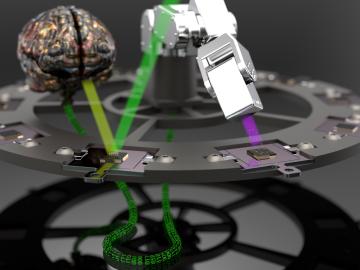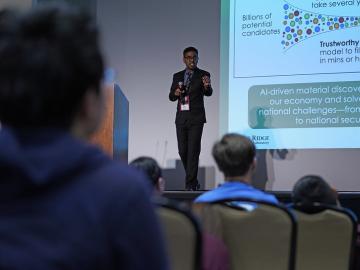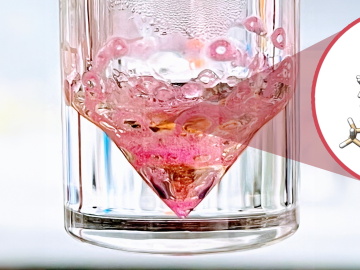Filter News
Area of Research
- Advanced Manufacturing (33)
- Biological Systems (17)
- Biology and Environment (174)
- Biology and Soft Matter (5)
- Building Technologies (12)
- Chemical and Engineering Materials (4)
- Chemistry and Physics at Interfaces (11)
- Clean Energy (487)
- Climate and Environmental Systems (13)
- Computational Biology (6)
- Computational Chemistry (5)
- Computational Engineering (5)
- Computer Science (17)
- Data (1)
- Earth Sciences (1)
- Electricity and Smart Grid (2)
- Energy Frontier Research Centers (14)
- Energy Sciences (4)
- Fossil Energy (3)
- Fuel Cycle Science and Technology (3)
- Functional Materials for Energy (14)
- Fusion and Fission (53)
- Fusion Energy (17)
- Geographic Information Science and Technology (3)
- Isotope Development and Production (2)
- Isotopes (34)
- Materials (401)
- Materials Characterization (2)
- Materials for Computing (36)
- Materials Synthesis from Atoms to Systems (13)
- Materials Under Extremes (12)
- Mathematics (1)
- National Security (77)
- Neutron Data Analysis and Visualization (4)
- Neutron Science (184)
- Nuclear Science and Technology (69)
- Nuclear Systems Modeling, Simulation and Validation (3)
- Nuclear Systems Technology (1)
- Quantum Condensed Matter (4)
- Quantum information Science (8)
- Reactor Technology (1)
- Renewable Energy (4)
- Sensors and Controls (5)
- Supercomputing (301)
- Transportation Systems (11)
News Type
Date
News Topics
- 3-D Printing/Advanced Manufacturing (110)
- Advanced Reactors (31)
- Artificial Intelligence (87)
- Big Data (45)
- Bioenergy (88)
- Biology (96)
- Biomedical (56)
- Biotechnology (20)
- Buildings (49)
- Chemical Sciences (59)
- Clean Water (28)
- Climate Change (91)
- Composites (24)
- Computer Science (176)
- Coronavirus (45)
- Critical Materials (24)
- Cybersecurity (34)
- Decarbonization (69)
- Education (4)
- Element Discovery (1)
- Emergency (2)
- Energy Storage (100)
- Environment (179)
- Exascale Computing (34)
- Fossil Energy (5)
- Frontier (38)
- Fusion (50)
- Grid (58)
- High-Performance Computing (79)
- Hydropower (11)
- Irradiation (2)
- Isotopes (47)
- ITER (7)
- Machine Learning (44)
- Materials (134)
- Materials Science (125)
- Mathematics (6)
- Mercury (12)
- Microelectronics (2)
- Microscopy (47)
- Molten Salt (8)
- Nanotechnology (54)
- National Security (54)
- Net Zero (12)
- Neutron Science (122)
- Nuclear Energy (96)
- Partnerships (42)
- Physics (54)
- Polymers (29)
- Quantum Computing (31)
- Quantum Science (64)
- Renewable Energy (2)
- Security (22)
- Simulation (44)
- Software (1)
- Space Exploration (25)
- Statistics (3)
- Summit (56)
- Sustainable Energy (118)
- Transformational Challenge Reactor (7)
- Transportation (86)
Media Contacts

An Oak Ridge National Laboratory team revealed how chemical species form in a highly reactive molten salt mixture of aluminum chloride and potassium chloride by unraveling vibrational signatures and observing ion exchanges.

Six firms received Small Business Awards from the Department of Energy’s Oak Ridge National Laboratory. The companies, selected from small business service providers to the lab, were recognized by ORNL's Small Business Programs Office for their specific capabilities and contributions.

Researchers at Oak Ridge National Laboratory have developed free data sets to estimate how much energy any building in the contiguous U.S. will use in 2100. These data sets provide planners a way to anticipate future energy needs as the climate changes.

Four ORNL scientists started their professional careers as staff scientists in the Distinguished Staff Fellowship program, a highly competitive, prestigious program for young scientists to begin a lifetime vocation in research at the lab.

Today, scientific discovery is accelerated by automated experiments, artificial intelligence and high-performance computing. A novel tool developed at ORNL that leverages those technologies has demonstrated that AI can influence materials synthesis and conduct associated experiments without human supervision.

When the Department of Energy’s Oak Ridge National Laboratory science mission takes staff off-campus, the lab’s safety principles follow. That’s true even in the high mountain passes of Washington and Oregon, where ORNL scientists are tracking a tree species — and where wildfires have become more frequent and widespread.

Purdue University hosted more than 100 attendees at the fourth annual Quantum Science Center summer school. Students and early-career members of the QSC —headquartered at ORNL — participated in lectures, hands-on workshops, poster sessions and panel discussions alongside colleagues from other DOE National Quantum Information Science Research Centers.

Researchers at ORNL and the University of Maine have designed and 3D-printed a single-piece, recyclable natural-material floor panel tested to be strong enough to replace construction materials like steel.

Prasanna Balaprakash, a national leader in artificial intelligence, or AI, spoke to some of the highest achieving students in the country at the National Science Bowl in Washington D.C.

A team from ORNL successfully characterized a coordination complex of the element Promethium. The research was supported by computational simulations of the element's electronic structure run on the IBM AC922 Summit supercomputer.




